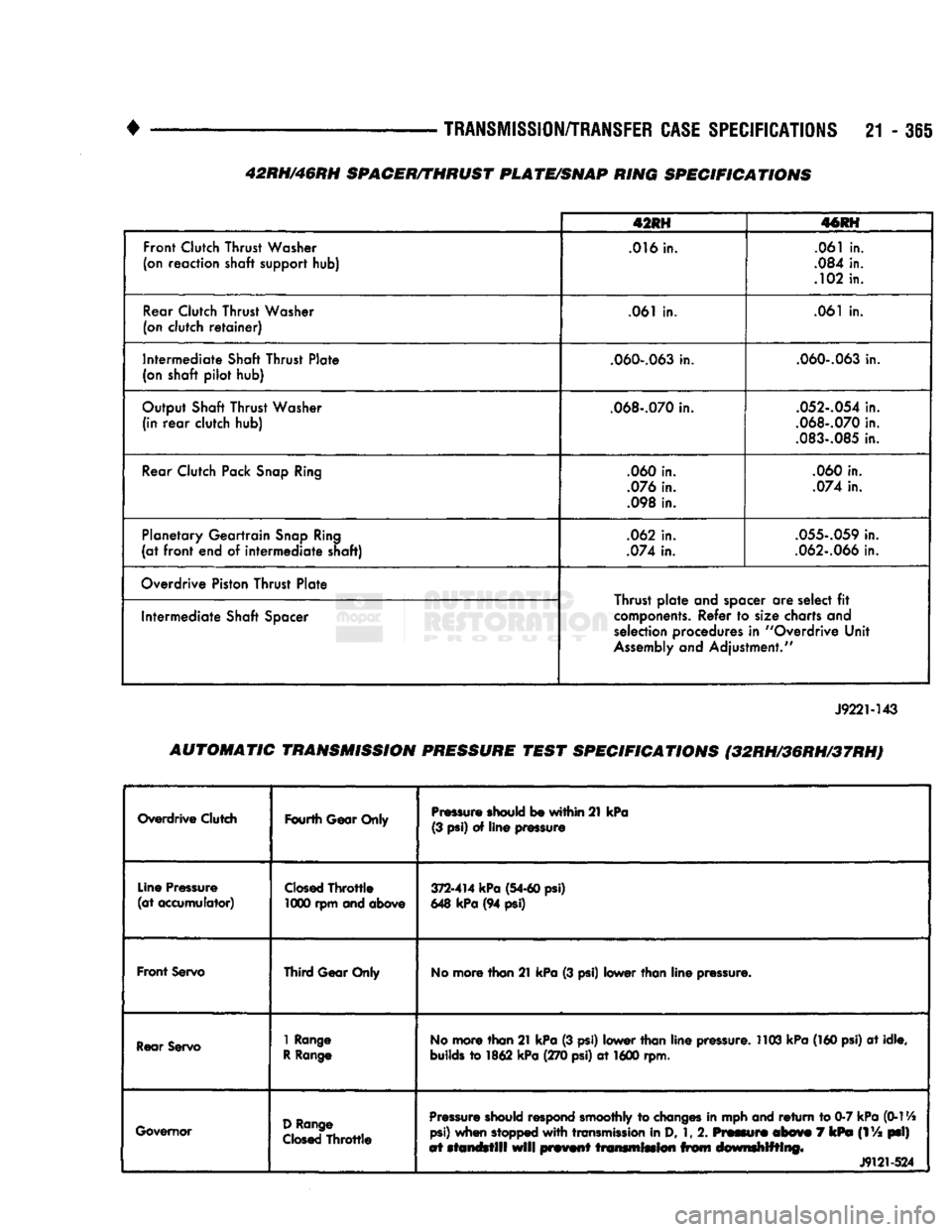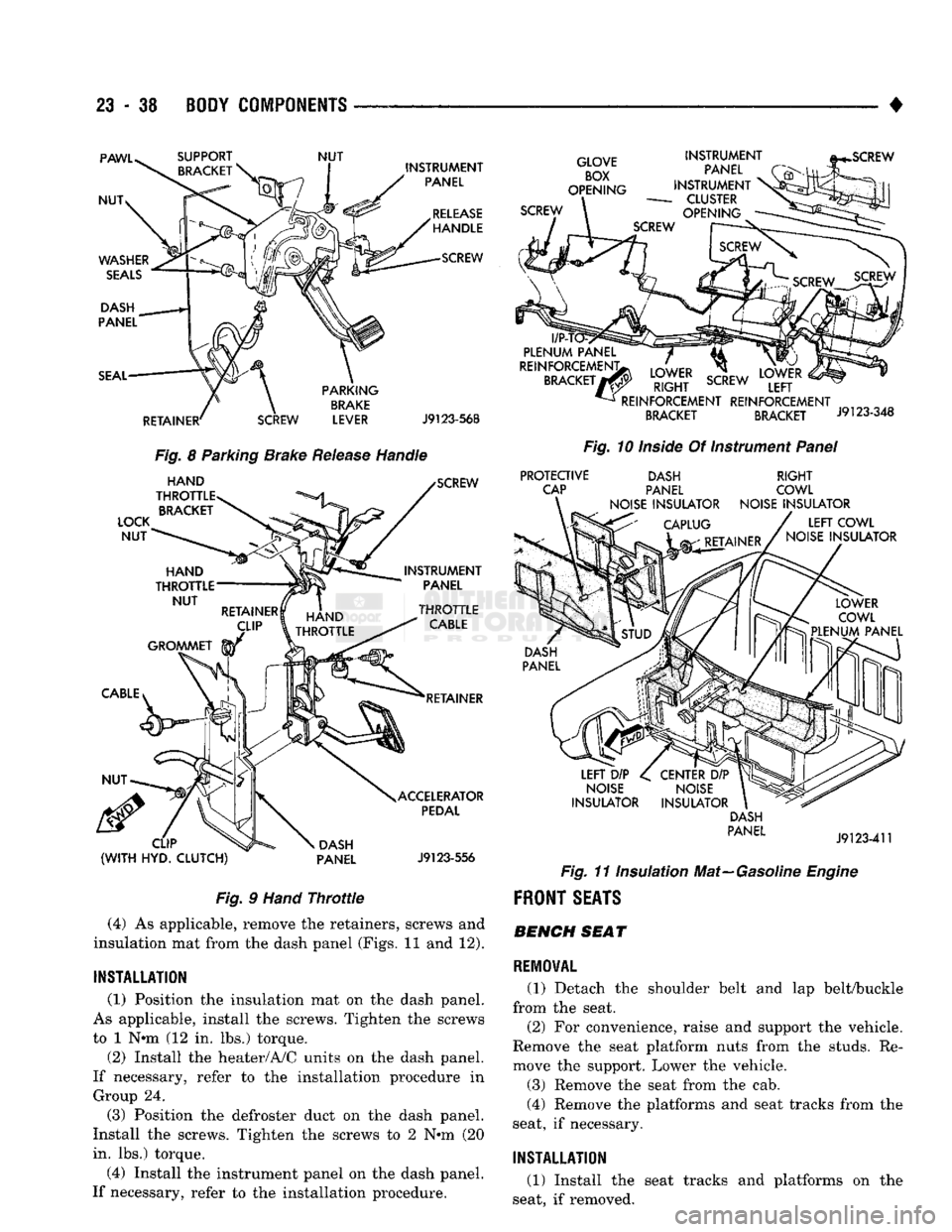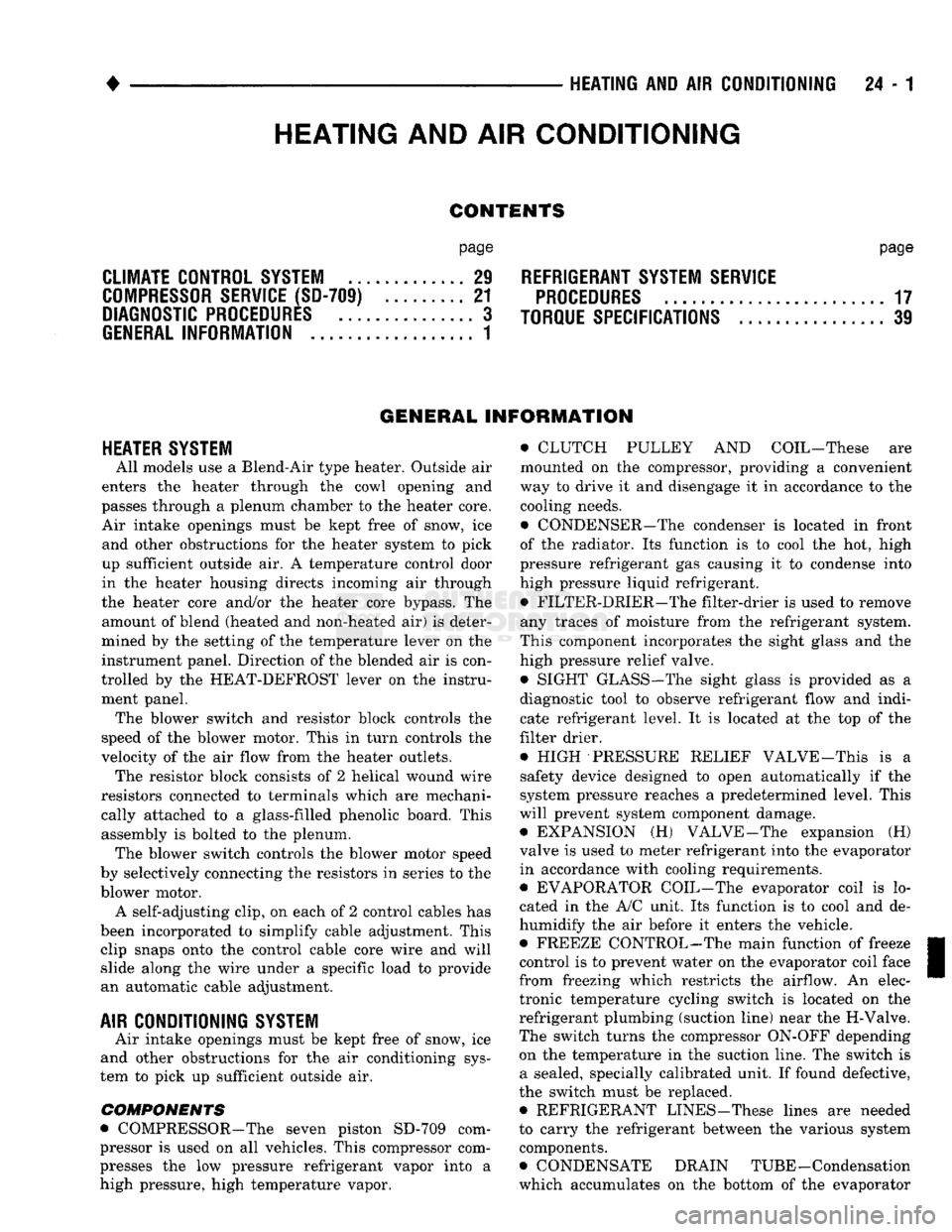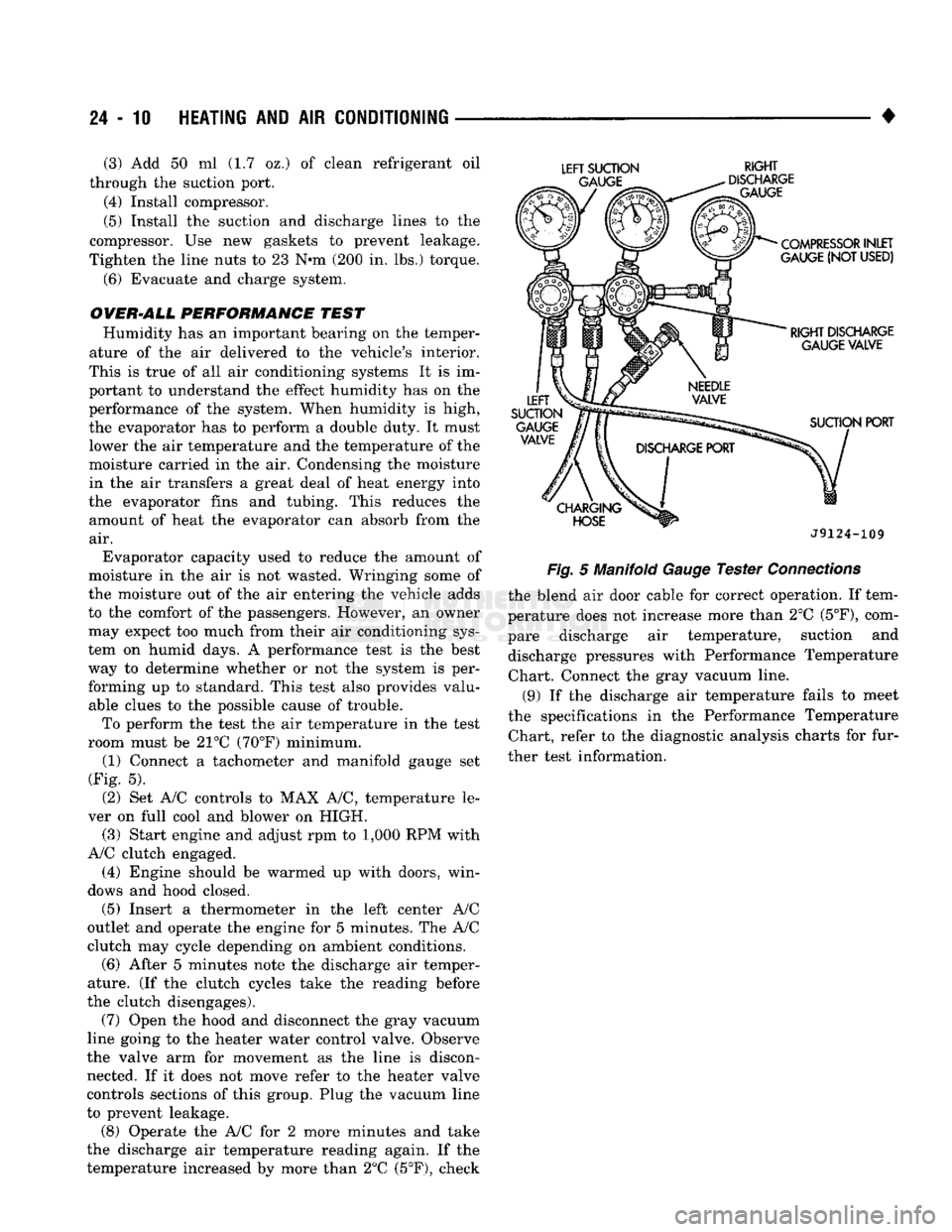1993 DODGE TRUCK clutch
[x] Cancel search: clutchPage 1366 of 1502

•
TRANSMISSION/TRANSFER CASE SPECIFICATIONS
21 - 365
411H
mm
Front Clutch Thrust Washer
(on reaction shaft support
hub)
.016
in.
.061
in.
.084
in.
.102
in.
Rear Clutch Thrust Washer
(on clutch retainer) .061
in.
.061
in.
Intermediate Shaft Thrust Plate
(on shaft pilot
hub)
.060-.063
in.
.060-.063
in.
Output Shaft Thrust Washer (in rear clutch
hub)
.068-.070
in.
.052-.054
in.
.068-.070
in.
.083-.085
in.
Rear Clutch
Pack
Snap Ring .060
in.
.076
in.
.098
in.
.060
in.
.074
in.
Planetary Geartrain Snap Ring
(at front
end of
intermediate shaft) .062
in.
.074
in.
.055-059
in.
.062-.066
in.
Overdrive Piston Thrust Plate Thrust plate
and
spacer
are
select
fit
components. Refer
to
size charts
and
selection procedures
in
"Overdrive Unit
Assembly
and
Adjustment."
Intermediate Shaft Spacer
Thrust plate
and
spacer
are
select
fit
components. Refer
to
size charts
and
selection procedures
in
"Overdrive Unit
Assembly
and
Adjustment."
J9221-143
AUTOMATIC TRANSMISSION PRESSURE TEST SPECIFICATIONS (32RH/36RH/37RH)
Overdrive Clutch
Fourth
Gear Only
Pressure
should be
within
21
kPa
(3
psi)
of
line
pressure
Line
Pressure
(at
accumulator)
Closed
Throttle
1000 rpm and above
372-414
kPa
(54-60
psi)
648
kPa
(94 psi)
Front
Servo
Third
Gear Only No
more than 21 kPa
(3
psi) lower than line
pressure.
Rear
Servo 1 Range
R
Range No
more than 21 kPa
(3
psi) lower than line
pressure.
1103 kPa
(160
psi)
at
idle,
builds
to
1862 kPa (270
psi)
at
1600 rpm.
Governor
D
Range
Closed
Throttle
Pressure
should
respond smoothly to changes in mph
and
return to
0-7
kPa
(0-114
psi)
when stopped
with
transmission
in D,
1,
2.
Pmmmf®
mb&wm
7
kPm
(1
Va
psi)
at
standstill
will
prmnf transmission from drnwrnhlfflmg*
J9121-524
42RH/46RH SPACER/THRUST PLATE/SNAP RING SPECIFICATIONS
Page 1367 of 1502

21 • 366
TRANSMISSION/TRANSFER
CASE
SPECIFICATIONS
•
Overdrive Clutch
Fourth Gear Only Pressure should be
469-496
kPa
(68-72
psi) with closed throttle and increase to
620-896
kPa
(90-130
psi) at 1/2 to 3/4 throttle.
Line Pressure
(at accumulator) Closed Throttle
1000
rpm and above
372-414
kPa
(54-60
psi)
648 kPa (94 psi)
Front Servo Third Gear Only No more than
21
kPa (3 psi) lower than line pressure.
Rear Servo
1
Range
R Range No more then
21
kPa (3 psi) lower than line pressure. 1103 kPa (160 psi) at idle,
builds to 1862 kPa (270 psi) at 1600 rpm.
Governor D Range
Closed Throttle Pressure should respond smoothly to changes in mph and return to 0-7 kPa
(0-1
Vi
psi) when stopped with transmission in D,
1,
2. Pressure
above
7
kPa
(IV2
psi)
at
standstill
will
prevent
transmission
from
downshifting.
J9321-192
AUTOMATIC
TRANSMISSION
TORQUE
SPECIFICATIONS
DESCRIPTION TORQUE DESCRIPTION TORQUE
Cooler Line Fittings 18 N-m (13 ft. lbs.)
Converter Bolts: 9.5 in.,
3-lug
converter 54 N-m (40 ft. lbs.
9.5 in., 4-lug converter 74 N-m (55 ft. lbs. 10.0 in., 4-lug converter 74 N-m (55 ft. lbs.
10.75 in., 4-lug converter 31 N-m (270 in. lbs.
Crossmember Bolts/Nuts 68 N-m (50 ft. lbs. Driveplate Bolts 75 N-m (55 ft. lbs.
Extension Housing Bolts 43 N-m (32 ft. lbs.
Front Band Reaction Pin Access Plug 17 N-m (13 ft. lbs.
Front Band Adjusting Screw Locknut 34 N-m (25 ft. lbs.
Governor Body-to-Park Gear Bolts 11 N-m (8 ft. lbs.
Lockup Module Screws 4 N-m (35 in. lbs.
Neutral Switch 34 N-m (25 ft. lbs.
Oil Filter Screws 4 N-m (35 in. lbs.
Oil Pan Bolt 17 N-m (13 ft. lbs.
Oil Pump Bolt 20 N-m (15 ft. lbs.
Overrunning Clutch Cam Set Screw (36RH/46RH) 5 N-m (40 in. lbs. Overrunning Clutch Cam Bolts 17 N-m (150 in. lbs.
Overdrive Compounder-to- Transmission Case Bolts 34 N-m (25 ft. lbs.
Overdrive Piston Retainer Bolts (42RH/46RH) 17 N-m (150 in. lbs.
Pressure Test Port Plugs 14 N-m (10 ft. lbs.
Propeller Shaft Clamp Bolts 19 N-m (170 in. lbs.
Reaction Shaft Support Bolts 20 N-m (15 ft. lbs.
Rear
Band
Adjusting Screw Locknut 41 N-m (30 ft. lbs.
Rear Mount Bolts/Nuts 68 N-m (50 ft. lbs.
Rear Support Bolts (32RH/36RH) 17 N-m (150 in. lbs.
Solenoid Wiring Connector Screw 17 N-m (13 ft. lbs.
Solenoid-to-Transfer Plate Screw 4 N-m (35 in. lbs.
Speedometer Adapter Bolt 11 N-m (8 ft. lbs.
Valve Body Housing Screws 4 N-m (35 in. lbs.
Valve Body-to-Case Bolts 12 N-m (100 in. lbs.
J9221-157
AUTOMATIC TRANSMISSION PRESSURE TEST SPECIFICATIONS (42RH/46RH)
Page 1368 of 1502

•
TRANSMISSION/TRANSFER
CASE
SPECIFICATIONS
21 - 367
DESCRIPTION
TORQUE
Backup Light Switch 22-34 N-m (193-300 in.
lbs.)
Countershaft Bearing Plate Bolts 19-26 N-m (170-230 in.
lbs.)
Fifth Gear Nut 339-475 N-m (250-350
ft. lbs.)
Drain
and
Fill Plugs 34-47 N-m (25-35
ft. lbs.)
Front Bearing Retainer Bolts 27-34 N-m (235-305 in.
lbs.)
Mainshaft Bearing Plate Bolts 19-26 N-m (170-230 in.
lbs.)
PTO
Cover Bolts 27-54 N-rn (20-40
ft.
lbs.)
Extension/Adapter Housing Bolts 41-68 N-m (30-50
ft.
lbs.)
Reverse Inhibitor Screws
8-14
N-m (75-115 in.
lbs.)
Shift Cover Bolts 27-31 N-m (216-276 in.
lbs.)
J9221-12
DESCRIPTION
TORQUE
Bearing Preload
Case
Bolts
Distance
Sensor
Coupling
Nut
Detent
Bolt
Drain/Fill
Plugs
Front/Rear Yoke Nuts Indicator Switch
Range
Lever
Locknut..
Rear
Retainer
Bolts
...
Speedometer Driven Gear
Nut
Transfer
Case
Mounting
Nuts.
. . . . 7-41
N»m
(5-30
in.
lbs.)
31
mm (23 ft. lbs.)
17
N»m
(150
in.
lbs.)
31
N»m (23 ft. lbs.) 54
N«m
(40 ft. lbs.) 176
N®m
(130 ft. lbs.)
24
N«m
(18 ft. lbs.)
10 N*m (90 in. lbs.)
54
N«m
(40 ft. lbs.)
11
N»m (100
in.
lbs.)
54
N«m
(40 ft. lbs.) J9221-250
G360
SET-TO
TORQUE
SPECIFICATIONS
NP241
TORQUE SPECIFICATIONS
Clutch Housing Bolts
47 N-m (35 ft. lbs.)
Drain/Fill Plugs
47 Nm (35 ft. lbs.)
Front/Rear Bearing
Retainer Bolts
.
22-30
N-m
(16-22
ft. lbs.)
Rear Crossmember Bolts/Nuts
. 68 N-m (50 ft. lbs.)
Shift Cover Bolts 22-30
N-m
(16-22
ft. lbs.)
Skid Plate
And
Crossmember Bolts/Nuts
41 N-m (30 ft. lbs.)
Transfer Case Attaching Nuts
47 Nm (35 ft. lbs.)
Transmission-To-Clutch Housing Bolts
68 N-m (35 ft. lbs.)
U-Joint Clamp Bolts
19 Nm (14 ft. lbs.)
Yoke
Nut 380 N-m (280 ft. lbs.)
J9321-333
DESCRIPTION
TORQUE
Oil Pump
Screws
1.4-1.8
N«m (12-15 in. lbs.)
Yoke
Nut (front/rear) 176-271 N»m (130-200 ft. lbs.)
Vacuum Switch
20-34 N«m (15-25 ft. lbs.)
Range
Lever
Nut
27-34 N»m (20-25 ft. lbs.)
Front
Case-To-Rear
Case
Bolts
.. 27-34 N»m (20-25 ft. lbs.)
Rear
Retainer
Bolts
47-61 N»m (35-45 ft. lbs.)
Extension
Housing
Bolts
35-46 N»m (26-34 ft. lbs.)
Drain/Fill
Plugs
41-54 N*m (30-40 ft. lbs.)
Detent
Plug
16-24
N@m
(12-18 ft. lbs.)
Front
Bearing
Retainer
Bolts
16-24 N»m (12-18 ft. lbs.)
Vacuum Switch
20-34 N*m (15-25 ft. lbs.)
Rear
Case
Stud
Nut 27-34 N*m (20-25 ft. lbs.)
Strut
Mounting Bracket Stud
Nut 27-34 N»m (20-25 ft. lbs.)
J9221-248
NV4500
TORQUE
SPECIFICATIONS
NP205
TORQUE
SPECIFICATIONS
Page 1421 of 1502

23 - 38
BODY COMPONENTS
— —
^—_____— —
•
PAWU
NUT
WASHER
SEALS
DASH
PANEL
SEAL
SUPPORT
BRACKET
NUT
INSTRUMENT
PANEL
RELEASE
HANDLE SCREW
RETAINER'
PARKING
BRAKE
SCREW LEVER J9123-568
Fig.
8 Parking Brake
Release
Handle
LOCK
NUT
HAND
THROTTLE BRACKET SCREW
INSTRUMENT PANEL
HAND
^TfJlLE
>TTLE
RETAINER
CLIP
(WITH
HYD.
CLUTCH)
DASH
PANEL ACCELERATOR
PEDAL
J9123-556
Fig.
9
Hand
Throttle
(4) As applicable, remove the retainers, screws and
insulation mat from the dash panel (Figs. 11 and 12).
INSTALLATION
(1) Position the insulation mat on the dash panel.
As applicable, install the screws. Tighten the screws
to 1 N«m (12 in. lbs.) torque.
(2) Install the heater/A/C units on the dash panel.
If necessary, refer to the installation procedure in Group 24.
(3) Position the defroster duct on the dash panel.
Install the screws. Tighten the screws to 2 N*m (20
in. lbs.) torque.
(4) Install the instrument panel on the dash panel.
If necessary, refer to the installation procedure.
GLOVE
BOX
OPENING
SCREW INSTRUMENT
PANEL
INSTRUMENT
-
CLUSTER
OPENING
l/P-T
PLENUM
PANEL
REINFORCEMENT;
BRACKET
7
LOWER
RIGHT
SCREW
REINFORCEMENT REINFORCEMENT
BRACKET BRACKET J9123-348
Fig.
10
Inside
Of Instrument
Panel
PROTECTIVE
CAP DASH
PANEL
NOISE
INSULATOR
RIGHT
COWL
NOISE
INSULATOR
LEFT
COWL
NOISE
INSULATOR
LEFT
DIP
NOISE
INSULATOR
CENTER
DIP
NOISE
INSULATOR DASH
PANEL
J9123-411
Fig.
11 Insulation Mat—Gasoline
Engine
FRONT
SEATS BENCH SEAT
REMOVAL
(1) Detach the shoulder belt and lap belt/buckle
from the seat.
(2) For convenience, raise and support the vehicle.
Remove the seat platform nuts from the studs. Re
move the support. Lower the vehicle.
(3) Remove the seat from the cab.
(4) Remove the platforms and seat tracks from the
seat, if necessary.
INSTALLATION
(1) Install the seat tracks and platforms on the
seat, if removed.
Page 1438 of 1502

•
• —• •
HEATING
AND AIR
CONDITIONING
24 - 1 CONTENTS
page
CLIMATE CONTROL SYSTEM
............. 21
REFRIGERANT SYSTEM SERWICE
COMPRESSOR
SERWICE
(SD-709)
......... 21
PROCEDURES
.............
DIAGNOSTIC PROCEDURES
3
TORQUE SPECIFICATIONS
GENERAL INFORMATION
1
page
. 17
. 31
GENERAL INFORMATION
HEATER SYSTEM
All models use a Blend-Air type heater. Outside air
enters the heater through the cowl opening and
passes through a plenum chamber to the heater core. Air intake openings must be kept free of snow, ice and other obstructions for the heater system to pick
up sufficient outside air. A temperature control door
in the heater housing directs incoming air through
the heater core and/or the heater core bypass. The amount of blend (heated and non-heated air) is deter
mined by the setting of the temperature lever on the
instrument panel. Direction of the blended air is con
trolled by the HEAT-DEFROST lever on the instru ment panel. The blower switch and resistor block controls the
speed of the blower motor. This in turn controls the
velocity of the air flow from the heater outlets. The resistor block consists of 2 helical wound wire
resistors connected to terminals which are mechani cally attached to a glass-filled phenolic board. This
assembly is bolted to the plenum. The blower switch controls the blower motor speed
by selectively connecting the resistors in series to the
blower motor.
A self-adjusting clip, on each of 2 control cables has
been incorporated to simplify cable adjustment. This clip snaps onto the control cable core wire and will slide along the wire under a specific load to provide
an automatic cable adjustment.
AIR
CONDITIONING
SYSTEM
Air intake openings must be kept free of snow, ice
and other obstructions for the air conditioning sys
tem to pick up sufficient outside air.
COMPONENTS
• COMPRESSOR-The seven piston SD-709 com
pressor is used on all vehicles. This compressor com
presses the low pressure refrigerant vapor into a high pressure, high temperature vapor. • CLUTCH PULLEY AND COIL-These are
mounted on the compressor, providing a convenient
way to drive it and disengage it in accordance to the cooling needs.
• CONDENSER-The condenser is located in front
of the radiator. Its function is to cool the hot, high
pressure refrigerant gas causing it to condense into
high pressure liquid refrigerant.
• FILTER-DRIER—The filter-drier is used to remove
any traces of moisture from the refrigerant system.
This component incorporates the sight glass and the
high pressure relief valve.
• SIGHT GLASS-The sight glass is provided as a
diagnostic tool to observe refrigerant flow and indi cate refrigerant level. It is located at the top of the
filter drier.
• HIGH -PRESSURE RELIEF VALVE-This is a safety device designed to open automatically if the
system pressure reaches a predetermined level. This
will prevent system component damage. • EXPANSION (H) VALVE-The expansion (H)
valve is used to meter refrigerant into the evaporator
in accordance with cooling requirements. • EVAPORATOR COIL-The evaporator coil is lo
cated in the A/C unit. Its function is to cool and de-
humidify the air before it enters the vehicle. • FREEZE CONTROL-The main function of freeze
control is to prevent water on the evaporator coil face
from freezing which restricts the airflow. An elec
tronic temperature cycling switch is located on the
refrigerant plumbing (suction line) near the H-Valve.
The switch turns the compressor ON-OFF depending
on the temperature in the suction line. The switch is a sealed, specially calibrated unit. If found defective,
the switch must be replaced. • REFRIGERANT LINES-These lines are needed
to carry the refrigerant between the various system components.
• CONDENSATE DRAIN TUBE-Condensation
which accumulates on the bottom of the evaporator
HEATING
AND AIR
CONDITIONING
Page 1444 of 1502

•
HEATING AND AIR CONDITIONING 24 - 7 AIR CONDITIONING SYSTEM
SIGHT GLASS REFRIGERANT LEWEL TEST The sight glass, which is an integral part of the fil
ter-drier, is a refrigerant level indicator (Fig. 2). To check the refrigerant level, clean the sight glass and
start the engine. Place the air conditioning controls
on A/C, the fan switch on high and the temperature lever on cool. The room temperature should be at
least 21°C (70°F). After operating for a few minutes
in this manner, check the sight glass.
SIGHT
GLASS
FILTER
DRIER
ASSEMBLY
9024-3
Fig.
2 Sight Glass
(1) If the sight glass is clear, the A/C clutch is en
gaged, the compressor discharge line is warm and
the compressor inlet line is cool; the system has a
full charge.
(2) If the sight glass is clear, the A/C clutch is en
gaged and there is not significant temperature differ
ence between compressor inlet and discharge lines;
the system is empty or nearly empty. Connect a gauge to the compressor discharge port. If the gauge
reads less than 172 kPag (25 psi), the suction tube cycling switch has failed.
(3) If the sight glass is clear and the A/C clutch is
disengaged; the clutch is defective or, the clutch circuit
is open, or the system is out of refrigerant. Perform suc
tion tube cycling switch test to determine condition.
(4) If the sight glass shows foam or bubbles, the
system could be low on charge. Occasional foam or
bubbles is normal when the room temperature is above 43°C (110°F) or below 21°C (70°F).
Adjust the engine speed to 1,300 RPM. Block the
airflow through the condenser to increase the com
pressor discharge pressure to 1 552-1 724 kPag (225- 250 psig). If sight glass still shows bubbles or foam,
system charge level is low. The refrigerant system will not be low on charge un
less there is a leak. Find and repair the leak. If the leak
can be repaired without discharging the system, the low
refrigerant charge level can be corrected as follows.
Maintaining the discharge pressure of 1 550-1 720 kPag (225-250 psig), add refrigerant gas through compressor
suction line until foam is cleared from sight glass. Then
add 13 oz. (368 g) or 1 can of refrigerant.
HIGH PRESSURE RELIEF
WALWE
The high pressure relief valve vents only a small
amount of refrigerant necessary to reduce system pres
sure and then reseats
itself.
The majority of the refrig
erant is conserved in the system. The valve is calibrated
to vent at a pressure of 3 100-3 790 kPag (450-550
psig).
However, the fact that the valve vented refriger ant, does not mean the valve is defective.
ELECTRONIC TEMPERATURE CYCLING
SWITCH TEST The electronic temperature cycling switch (Fig. 3) is
located on the refrigerant plumbing, suction line near
the H-valve. It electrically inputs to the engine control ler on gasoline vehicles and in series with the clutch
coil on diesel vehicles. The switch turns the compressor
on and off depending on the temperature in the suction
line.
The switch is a sealed, specially calibrated unit and if found defective, must be replaced.
ELECTRONIC
TEMPERATURE
CYCLING
SWITCH
J9324-97
Fig.
3 Electronic
Temperature
Cycling
Switch
(1) Remove the wires (boot connector) from the
electronic temperature cycling switch. (2) Check continuity of the switch. Switch contacts
are closed at temperatures above 45°F (7°C). If no
continuity, replace switch.
(3) If contacts are closed, verify switch operation as
follows:
(a) Connect wires to cycling switch.
(b) Set temperature control lever to full cool position. (c) Set A/C blower motor on low speed and push
A/C button.
(d) Operate engine at 1,300 RPM for approxi
mately 5 minutes to stabilize the A/C system and
verify that refrigerant system is full.
Page 1445 of 1502

24 - 8
HEATING
AND AIR
CONDITIONING
• (e) If compressor clutch cycles 3 to 10 times per
minute with temperature between 20°C-32°C (68°F-
90°F),
the cycling switch is normal. If the compressor
clutch fails to engage, check for continuity in the elec
trical circuit. Above 32°C (90°F) the compressor clutch
may be continuously engaged (non-cycling) due to the
high heat load. This condition is normal.
(4)
Refer to the Evaporator Heater Assembly for
the Removal/Installation procedures.
TESTING
THE
SYSTEM
FOR
LEAKS
If the air conditioning system is not cooling properly,
check that the refrigerant system is fully charged with
R-12.
Follow the procedures in the Sight Glass Refrig
erant Level Test section of this group.
If the refrigerant system is empty or low in refrig
erant charge, a leak at any of the line fittings or
component seals is likely (Fig. 4). To detect a leak in
the refrigerant system, perform one of the following
procedures as indicated by the symptoms.
ELECTRONIC
TEMPERATURE CYCLING
SWITCH
EXPANSION
"H"
VALVE
J9324-96
Fig.
4 Testing for
Leaks
EMPTY REFRIGERANT SYSTEM LEAK TEST
(1) Evacuate the refrigerant system to the lowest
degree of vacuum possible.
(2) Prepare a 14 oz. refrigerant (R-12) charge to be
injected into the system. (3) Connect and dispense 14 ozs. of refrigerant (R-
12) into the evacuated refrigerant system, (4) Proceed to Step 2 of Low Refrigerant Level
Leak Test.
LOW REFRIGERANT LEVEL LEAK TEST
(1) Review the Safety Precautions section of this
group to determine if there is still R-12 in the refrig
erant system. (2) Position the vehicle in a breeze free work area
to make it less difficult to detect a small leak. (3) With the engine not running, use an Electronic
Leak Detector, or equivalent, to search for leaks in
the most accessible areas first.
(a) Fittings, lines, or components that appear
oily usually will implicate a refrigerant leak.
(b) To inspect the evaporator core for leaks, it is
possible to insert the leak detector probe into the opening on the right side of the instrument panel.
COMPRESSOR OIL LEVEL It is important to have the correct amount of oil in
the A/C system to ensure proper lubrication of the compressor. Too little oil will result in damage to the
compressor. Too much oil will reduce the cooling ca
pacity of the system and consequently result in
higher discharge air temperatures.
To provide the desired balance for adequate lubri
cation and cooling capacity, each compressor is
charged with 135 ml (4.6 oz.) of oil at the factory.
The oil used in the compressors is a 500 SUS vis
cosity, wax-free refrigerant oil. Only refrigerant oil of the same type should be used to service the sys
tem. Do not use any other oil. The oil container should be kept tightly capped until it is ready for
use,
and then tightly capped after use to prevent en
trance of dirt and moisture. Refrigerant oil will quickly absorb any moisture it comes in contact with.
After the compressor has been installed and operated
in the A/C system, the oil will be distributed through
out the system. Some of the oil will be trapped by com
ponents in the system. An equivalent amount of oil
must be added to the system to compensate for the
trapped oil when replacing the following: • Evaporator Coil: 59.2 ml (2 oz.)
• Condenser: 30 ml (1 oz.)
• Filter-Drier: 30 ml (1 oz.) It will not be necessary to check oil level in the
compressor or to add oil unless there has been an oil
loss.
Oil loss at a leak point will be evident by the
presence of a wet, shiny surface around the leak. Replacement compressors are also charged with
135 ml (4.6 oz.). When replacing compressor; remove,
drain oil, measure amount and discard old oil. For
the replacement compressor use the same amount of refrigerant oil as recovered from the failed compressor. This adjustment is not needed if the system has
been flushed, removing retained oil. The Compressor Oil Level Adjustment Chart
should be followed to determine the need to perform
an oil level adjustment. Check oil level (basic fill) as follows: (1) Slowly discharge complete system.
(2) With system discharged, disconnect suction and
discharge lines and remove compressor. Drain and dis card oil through suction port and discharge port on top.
Page 1447 of 1502

24 - 10
HEATING
AND AIR
CONDITIONING
•
(3) Add 50 ml (1.7 oz.) of clean refrigerant oil
through the suction port.
(4) Install compressor.
(5) Install the suction and discharge lines to the
compressor. Use new gaskets to prevent leakage.
Tighten the line nuts to 23 N*m (200 in. lbs.) torque.
(6)
Evacuate and charge system.
OVER-ALL
PERFORMANCE
TEST
Humidity has an important bearing on the temper
ature of the air delivered to the vehicle's interior.
This is true of all air conditioning systems It is im
portant to understand the effect humidity has on the
performance of the system. When humidity is high,
the evaporator has to perform a double duty. It must lower the air temperature and the temperature of the
moisture carried in the air. Condensing the moisture
in the air transfers a great deal of heat energy into
the evaporator fins and tubing. This reduces the amount of heat the evaporator can absorb from the
air.
Evaporator capacity used to reduce the amount of
moisture in the air is not wasted. Wringing some of
the moisture out of the air entering the vehicle adds
to the comfort of the passengers. However, an owner may expect too much from their air conditioning sys
tem on humid days. A performance test is the best
way to determine whether or not the system is per
forming up to standard. This test also provides valu able clues to the possible cause of trouble.
To perform the test the air temperature in the test
room must be 21°C (70°F) minimum. (1) Connect a tachometer and manifold gauge set
(Fig. 5).
(2) Set A/C controls to MAX A/C, temperature le
ver on full cool and blower on HIGH. (3) Start engine and adjust rpm to 1,000 RPM with
A/C clutch engaged.
(4) Engine should be warmed up with doors, win
dows and hood closed.
(5)
Insert a thermometer in the left center A/C
outlet and operate the engine for 5 minutes. The A/C
clutch may cycle depending on ambient conditions.
(6)
After 5 minutes note the discharge air temper
ature. (If the clutch cycles take the reading before
the clutch disengages).
(7) Open the hood and disconnect the gray vacuum
line going to the heater water control valve. Observe
the valve arm for movement as the line is discon nected. If it does not move refer to the heater valve
controls sections of this group. Plug the vacuum line
to prevent leakage.
(8) Operate the A/C for 2 more minutes and take
the discharge air temperature reading again. If the
temperature increased by more than 2°C (5°F), check
LEFT
SUCTION
RIGHT
J9124-109
Fig.
5 Manifold
Gauge
Tester
Connections
the blend air door cable for correct operation. If tem
perature does not increase more than 2°C
(5°F),
com
pare discharge air temperature, suction and discharge pressures with Performance Temperature Chart. Connect the gray vacuum line.
(9) If the discharge air temperature fails to meet
the specifications in the Performance Temperature Chart, refer to the diagnostic analysis charts for fur
ther test information.